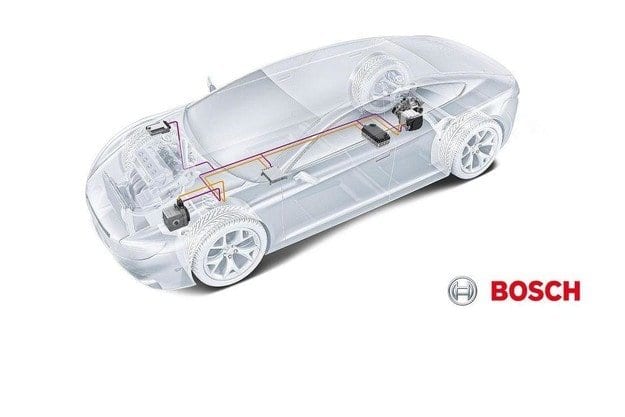
What is a hybrid car system?
Content
Recently, electric powered vehicles have gained great popularity. However, full-fledged electric cars have a significant drawback - a small power reserve without recharging. For this reason, many leading automakers are equipping some of their models with hybrid systems.
In fact, a hybrid car is a vehicle whose main power unit is an internal combustion engine, but it is strengthened by an electric system with one or more electric motors and an additional battery.
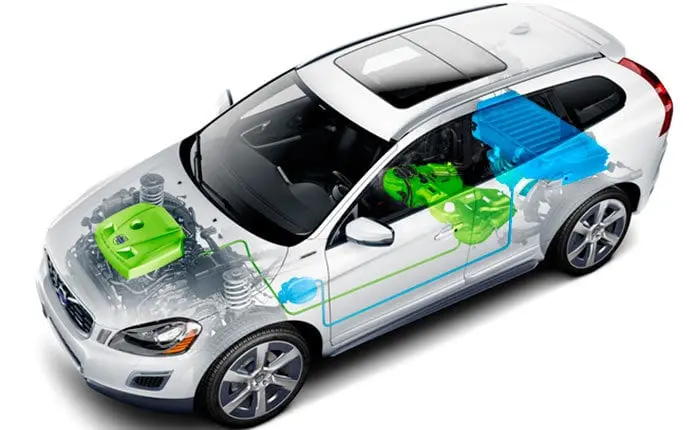
To date, several categories of hybrids are used. Some just help ICE at the start, others allow you to ride using electric traction. Consider the features of such power plants: what is their difference, how they work, as well as the main pros and cons of hybrids.
Hybrid Engine History
The idea of creating hybrid cars (or a cross between a classic car and an electric car) is due to a rise in price of fuel, toughening the standards for car emissions and providing greater comfort when driving.
The development of a mixed power plant was first undertaken by the French company Parisienne de voitures electriques. However, the first workable hybrid car was the creation of Ferdinand Porsche. In the Lohner Electric Chaise power plant, the internal combustion engine served as a generator for electricity, from which the front two electric motors worked (installed directly on the wheels).

The vehicle was introduced to the public in 1901. In total, about 300 copies of such cars were sold. The model turned out to be very practical, but expensive to manufacture, so an ordinary motorist could not afford such a vehicle. Moreover, at that time a cheaper and no less practical car appeared, developed by designer Henry Ford.
Classic gasoline power units forced developers for many decades to abandon the idea of creating hybrids. Interest in green transportation increased with the passage of the U.S. Citizens Promotion Bill. It was adopted in 1960.
By coincidence, the world oil crisis erupted in 1973. If US laws did not encourage manufacturers to think about developing affordable green cars, then the crisis forced them to do so.
The first full-fledged hybrid system, the basic principle of which is still used, was developed by TRW in 1968. According to the concept, it was possible to use a smaller internal combustion engine together with an electric motor, but at the same time the power of the machine was not lost, and the work became much smoother.
An example of a full-fledged hybrid car is the GM 512 Hybrid. He worked from an electric motor, which accelerated the vehicle to 17 km / h. At this speed, the internal combustion engine was activated, enhancing the performance of the system, so that the speed of the car increased to 21 km / h. If there was a need to go faster, the electric motor was turned off, and the car was already accelerating on a gasoline engine. The speed limit was 65 km / h.
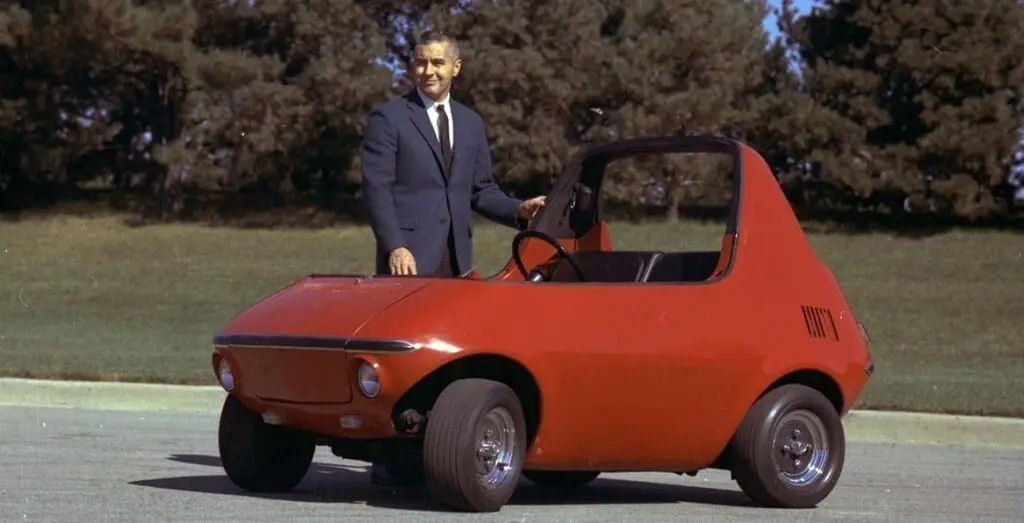
VW Taxi Hybrid - another successful instance of a hybrid car, was introduced to the public in 1973.
Until now, automakers are trying to bring hybrid and fully electric systems to a level that would make them competitive in comparison with classic ICEs. Although this has not yet happened, many of the developments justified the billions of dollars spent on their development.
With the beginning of the third millennium, mankind saw a novelty called Toyota Prius. The brainchild of the Japanese manufacturer has become synonymous with the concept of "hybrid car". Many modern developments are borrowed from this development. To date, a large number of modifications of combined installations have been created, which allows the buyer to choose the best option for himself.
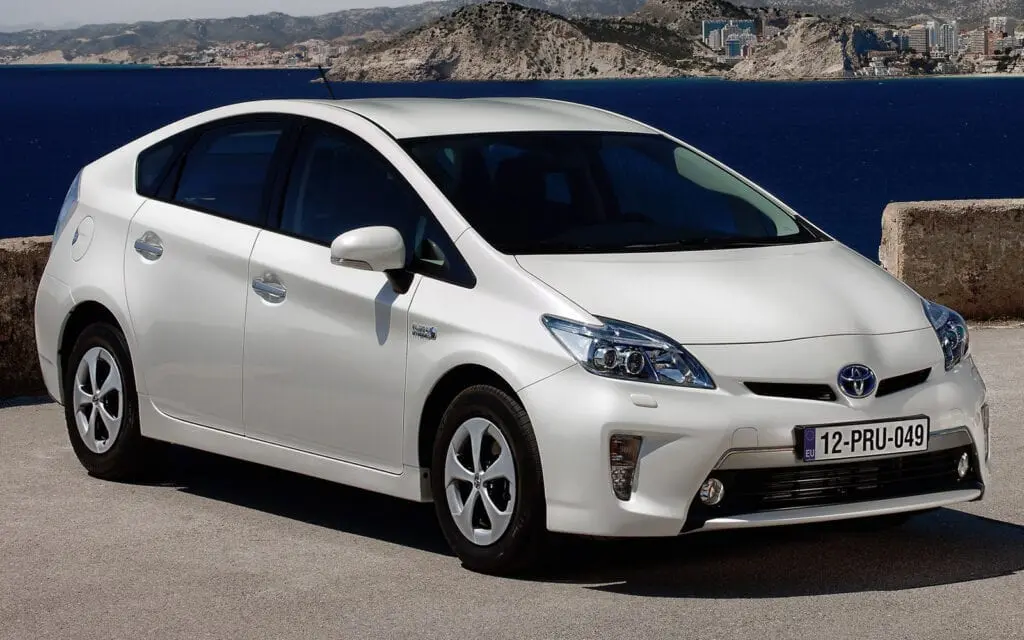
The principle of operation of hybrid cars
Do not confuse a hybrid motor with a full electric car. Electrical installation is involved in some cases. For example, in urban mode, when the car is in traffic, the use of an internal combustion engine leads to its overheating, as well as to an increase in air pollution. For such situations, an electrical installation is activated.
By design, the hybrid consists of:
- The main power unit. This is a gasoline or diesel engine.
- Electric motor. Depending on the modification, there may be several. By the principle of action, they can also be different. For example, some can be used as an additional drive for wheels, while others can be used as an assistant to the engine when starting the machine from a place.
- Extra battery. In some cars, it has a small capacity, the energy reserve of which is enough to activate for a short period of electrical installation. In others, this battery has a large capacity so that vehicles can move freely from electricity.
- Electronic control system. Complex sensors monitor the operation of the internal combustion engine and analyze the behavior of the machine, on the basis of which the electric motor is activated / deactivated.
- Inverter. This is a converter of the necessary energy coming from the battery to a three-phase electric motor. This element also distributes the load to different nodes depending on the modification of the installation.
- Generator. Without this mechanism, it is not possible to recharge the primary or secondary battery. As in ordinary cars, the generator is driven by the engine.
- Recuperation systems. Most modern hybrids are equipped with such a system. It "collects" additional energy from such components of the car as the brake system and chassis (when the car is coasting, for example, from a hill, the converter collects the released energy into the battery).

The power units of the hybrid installation can work both individually and in pairs.
Work schemes
There are several successful hybrid operation schemes. There are three main ones:
- sequential;
- parallel;
- serial-parallel.
Sequential circuit
In this case, the internal combustion engine is used as an electricity generator for the operation of electric motors. In fact, a gasoline or diesel engine does not have a direct connection with a car's transmission.
This system allows you to install low-power engines with a small volume in the engine compartment. Their main task is to operate a voltage generator.
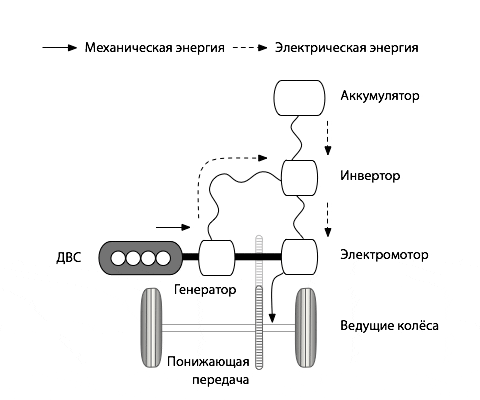
Such cars are often equipped with a recovery system, through which mechanical and kinetic energy is converted into electric current to recharge the battery. Depending on the size of the battery, a car can travel a certain distance exclusively on electric traction without using an internal combustion engine.
The most famous example of this category of hybrids is the Chevrolet Volt. It can be charged like a normal electric car, but thanks to the gasoline engine, the range is significantly increased.
Parallel circuit
In parallel installations, the internal combustion engine and the electric motor are paired. The task of the electric motor is to reduce the load on the main unit, which leads to significant fuel savings.
If you disconnect the engine from the transmission, the machine is able to overcome a certain distance from the electric traction. But the main task of the electrical part is to ensure smooth acceleration of the vehicle. The main power unit in such modifications is a gasoline (or diesel) engine.

When a car slows down or moves from the internal combustion engine, the electric motor acts as a generator to recharge the battery. Thanks to the operation of the internal combustion engine in such cars, a high-voltage battery is not required.
Unlike sequential hybrids, these units have higher fuel consumption, since the electric motor is not used as a separate power unit. In some models, such as the BMW 350E iPerformance, the electric motor is integrated into the gearbox.
A feature of this work scheme is a high rate of torque at low crankshaft speeds.
Serial parallel circuit
This scheme was developed by Japanese engineers. It is called HSD (Hybrid Synergy Drive). In fact, it combines the functions of the first two types of operation of power plants.
When a car needs to start or move slowly in a toffee, an electric motor is activated. To save energy at high speed, a gasoline or diesel engine (depending on the vehicle model) is connected.
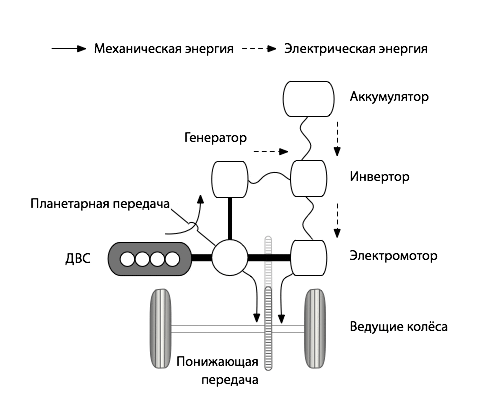
If you need to accelerate sharply (for example, when overtaking) or the car goes uphill, the power plant works in parallel mode - the electric motor helps the internal combustion engine, which reduces the load on it, and, as a result, saves fuel consumption.
The planetary connection of the automobile internal combustion engine transfers part of the power to the main transmission of the transmission, and part to the generator to recharge the battery or electric drive. In such a scheme, complex electronics are installed that distributes energy in accordance with the situation.
The most prominent example of a hybrid with a series-parallel powertrain is the Toyota Prius. However, some modifications of well-known Japanese-made models have already received such installations. An example of this is the Toyota Camry, Toyota Highlander Hybrid, Lexus LS 600h. This technology was also bought by some American concerns. For example, the development has found its way into the Ford Escape Hybrid.
Types of Hybrid Aggregates
All hybrid powertrains are divided into three types:
- soft hybrid;
- medium hybrid;
- full hybrid.
Each of them has its own function, as well as unique characteristics.
Micro Hybrid Powertrain
Such power plants are often equipped with a recovery system so that kinetic energy is converted into electrical energy and returned to the battery.

The drive mechanism in them is a starter (can also serve as a generator). There is no electric wheel drive in such installations. The scheme is used for frequent starts of ICE.
Mid Hybrid Powertrain
Such cars also do not move due to the electric motor. The electric motor in this case serves as an assistant to the main power unit with increasing load.

Such systems are also equipped with a recovery system, collecting free energy back into the battery. Medium hybrid units provide greater efficiency for the heat engine.
Full Hybrid Powertrain
In such installations, there is a high power generator, which is driven by the engine. The system is activated at low vehicle speeds.

The effectiveness of the system is manifested in the presence of the “Start / Stop” function, when the car moves slowly in traffic, but at the traffic light you need to accelerate sharply. A feature of the full hybrid installation is the ability to turn off the internal combustion engine (the clutch is turned off) and go on an electric motor.
Electrification Classification
The following terms may appear in the technical documentation or in the name of the car model:
- microhybrid;
- soft hybrid;
- full hybrid;
- plug-in hybrid.
Microhybrid
In such cars a conventional engine is installed. They do not have an electric drive. Such systems are either equipped with a “start / stop” function, or are equipped with a regenerative braking system (during braking, additional recharging of the battery occurs).
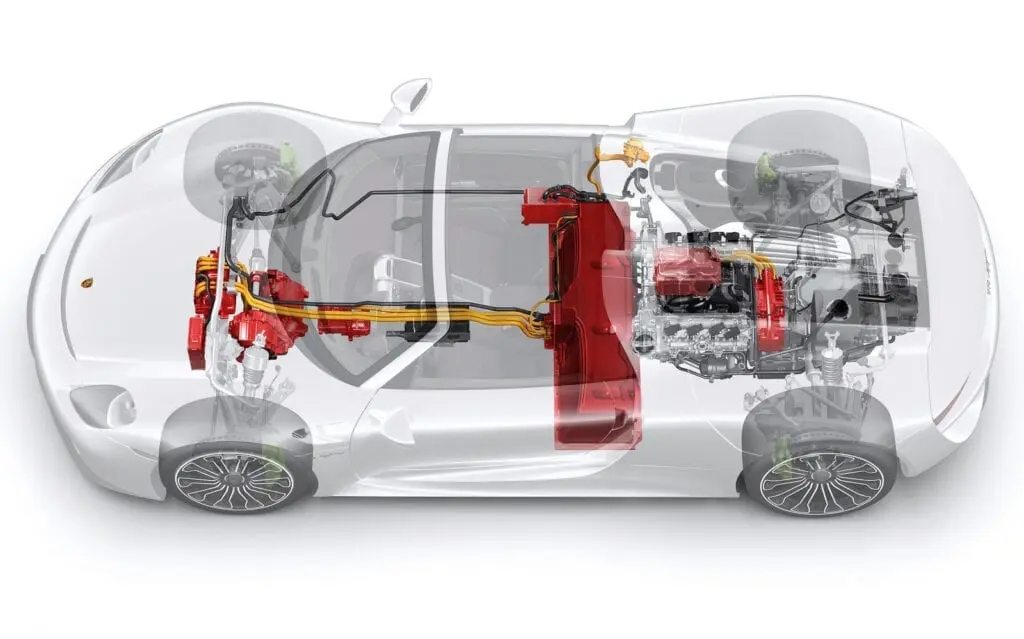
Some models are equipped with both systems. Some experts believe that such a transport is not considered a hybrid transport, because it uses only a gasoline or diesel power unit without integration into the electric drive system.
Soft hybrid
Such cars also do not move due to electricity. They also use a heat engine, as in the previous category. With one exception, the internal combustion engine is supported by an electrical installation.
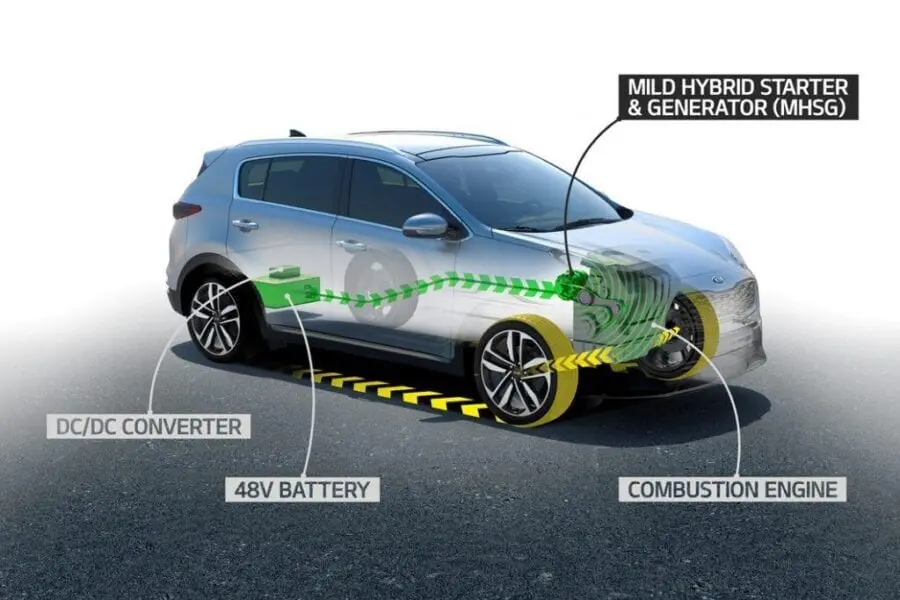
In such models there is no flywheel. Its function is performed by an electric starter-generator. The electrical system increases the return of a low-power motor with sharp acceleration.
Full hybrid
By these vehicles are meant vehicles capable of covering a certain distance on electric traction. In such models, any connection scheme mentioned above can be used.
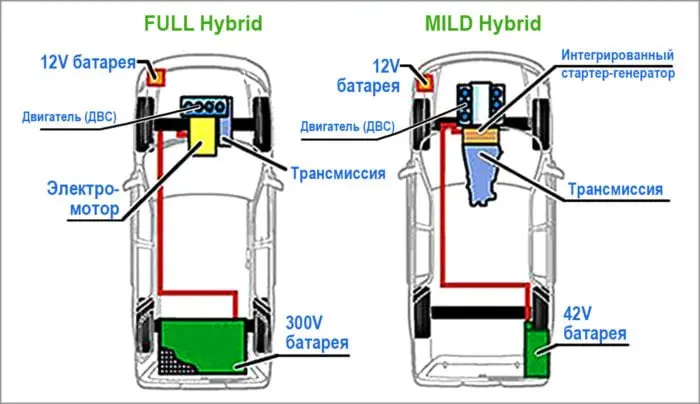
Such hybrids are not charged from the network. The battery is replenished with energy due to the work of the regenerative braking system and generator. The distance that can be covered on a single charge depends on the battery capacity.
Plug-in hybrids
Such cars can function as an electric car or work from the internal combustion engine. Thanks to the combination of two power plants provides decent fuel economy.
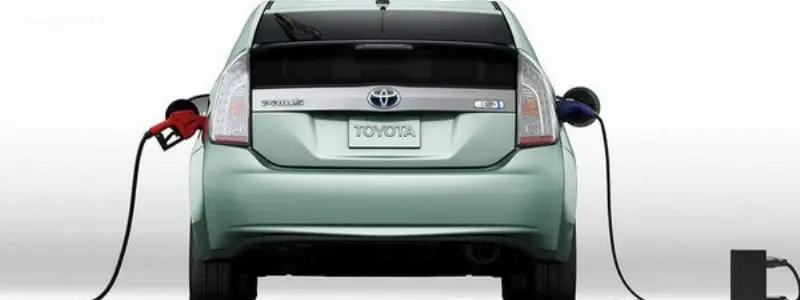
Since it is physically impossible to install a volumetric battery (in electric vehicles it takes the place of a gas tank), such a hybrid can cover up to 50 km on a single charge without recharging.
Advantages and disadvantages of hybrid cars
At the moment, the hybrid can be considered a transitional link from a thermal motor to an environmentally friendly electrical analogue. Although the final goal has not yet been achieved, thanks to the introduction of modern innovative developments, there is a positive trend in the development of electric vehicles.
Since hybrids are a transitional option, they have both positive and negative points. The pros include:
- Fuel economy. Depending on the scheme of operation of the power pair, this indicator may increase to 30% or more.
- Recharging without using an electrical outlet. This was made possible thanks to the kinetic energy recovery system. Although, a full charge does not occur, if the engineers can improve the conversion, then electric cars will cease to need an outlet at all.
- The ability to install a motor of less volume and power.
- Electronics is much more economical than mechanics to distribute fuel.
- The engine overheats less and fuel is consumed when driving in traffic jams.
- The combination of gasoline / diesel and electric engines allows you to continue driving if the high-power battery is dead.
- Thanks to the operation of the electric motor, the internal combustion engine can work more stably and less noisily.
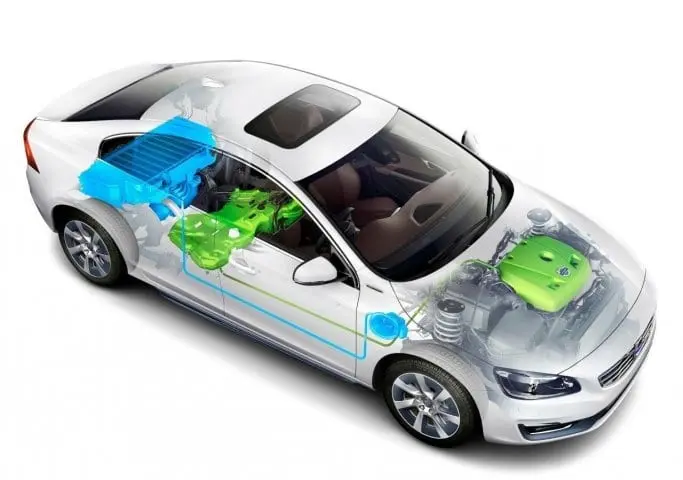
Hybrid plants also have a decent list of disadvantages:
- The battery becomes unusable faster due to the large number of charge / discharge cycles (even in soft hybrid systems);
- The battery is often completely discharged;
- Parts for such cars are quite expensive;
- Self-repair is almost impossible, as this requires sophisticated electronic equipment;
- Compared to gas or diesel models, hybrids cost several thousand dollars more;
- Regular maintenance is more expensive;
- Sophisticated electronics require careful handling, and errors that occur can sometimes interrupt a long journey;
- It is difficult to find a specialist who could properly configure the operation of power plants. Because of this, you have to resort to the services of expensive professional ateliers;
- The batteries do not tolerate significant temperature fluctuations and discharge themselves.
- Despite the environmental friendliness during the operation of the electric motor, the production and disposal of batteries strongly pollutes the environment.
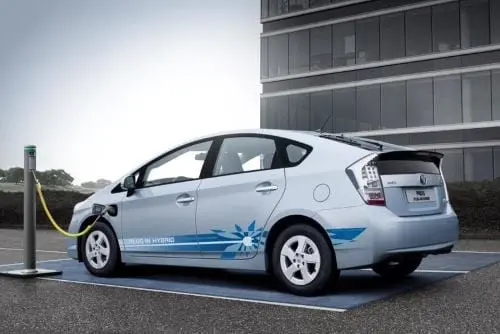
In order for hybrids and electric cars to compete with internal combustion engines, an improvement in power sources is required (so that they accumulate more energy, but at the same time they are not very voluminous), as well as fast charging systems without harm to the battery.
Questions and answers:
What is a hybrid vehicle? This is a vehicle in which more than one power unit is involved in its movement. Basically it is a mixture of an electric car and a car with a classic internal combustion engine.
What is the difference between a hybrid and a conventional car? A hybrid car has the advantages of an electric car (silent operation of the engine and driving without using fuel), but when the battery charge drops, the main power unit (gasoline) is activated.
